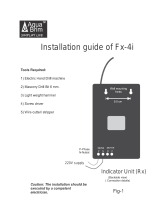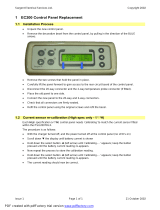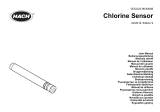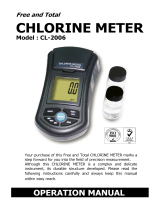Page is loading ...

DULCOMETER
®
Multi-parameter Controller diaLog DACa
Assembly and operating instructions
A1111
Part no. 985250 BA DM 203 04/14 EN
Please carefully read these operating instructions before use! · Do not discard!
The operator shall be liable for any damage caused by installation or operating errors!
Technical changes reserved.

General non-discriminatory approach
In order to make it easier to read, this
document uses the male form in grammat‐
ical structures but with an implied neutral
sense. It is aimed equally at both men and
women. We kindly ask female readers for
their understanding in this simplification of
the text.
Supplementary information
Read the following supplementary infor‐
mation in its entirety!
The following are highlighted separately in
the document:
n Enumerated lists
Instructions
ð
Results of the instructions
Information
This provides important information
relating to the correct operation of the
system or is intended to make your
work easier.
Safety information
Safety information are provided with
detailed descriptions of the endangering
situation, see
Ä Chapter 4.1 ‘Explanation
of the safety information’ on page 18
Supplemental instructions
2

Table of contents
1 Operating Concept.................................................................................................. 8
1.1 Functions of the keys .................................................................................. 11
1.2 Changes the set operating language........................................................... 12
1.3 Acknowledging Error or Warning Messages ............................................... 13
1.4 Key Lock ...................................................................................................... 13
2 Entries in the
[Menu]
display................................................................................. 14
3 ID Code................................................................................................................. 15
3.1 A complete measuring station may comprise the following:......................... 17
4 Safety and Responsibility..................................................................................... 18
4.1 Explanation of the safety information........................................................... 18
4.2 General safety notes.................................................................................... 19
4.3 Intended Use................................................................................................ 20
4.4 Users' qualifications...................................................................................... 21
5 Functional description........................................................................................... 23
6 Assembly and installation..................................................................................... 24
6.1 Scope of supply............................................................................................ 26
6.2 Mechanical Installation................................................................................. 26
6.2.1 Wall mounting............................................................................................ 26
6.2.2 Control Panel Installation.......................................................................... 28
6.3 Electrical installation..................................................................................... 31
6.3.1 Specification of the threaded connectors.................................................. 32
6.3.2 Terminal diagram...................................................................................... 33
6.3.3 Cable Cross-Sections and Cable End Sleeves......................................... 42
6.3.4 Wall mounting and control panel installation............................................. 43
6.3.5 Switching of inductive loads...................................................................... 44
6.3.6 Connect the sensors electrically to the controller...................................... 45
6.4 Priming to bleeding....................................................................................... 49
7 Commissioning..................................................................................................... 50
7.1
Switch-on behaviour during commissioning................................................. 50
7.2 Adjusting the backlight and contrast of the controller display....................... 51
7.3 Resetting the operating language................................................................ 51
7.4 Defining metering and control processes..................................................... 51
Table of contents
3

8 Setting measured variables.................................................................................. 52
8.1 Information on the measured variables........................................................ 53
8.1.1 Measured Variable pH [mV]...................................................................... 54
8.1.2 Temperature.............................................................................................. 54
8.1.3 Measured variable pH [mA]....................................................................... 55
8.1.4 ORP [mV], ORP [mA]................................................................................ 55
8.1.5 Chlorine, bromine, chlorine dioxide, chlorite, dissolved oxygen and
ozone......................................................................................................... 56
8.1.6 Fluoride Measured Variable...................................................................... 58
8.1.7 Peracetic Acid........................................................................................... 58
8.1.8 Hydrogen Peroxide.................................................................................... 59
8.1.9 Conductivity [mA] ..................................................................................... 59
8.1.10 Temperature [mA], (as main measured variable).................................... 59
8.1.11 mA General............................................................................................. 60
8.1.12 Features of the Two-channel Version..................................................... 60
9 Calibration............................................................................................................. 61
9.1 Calibrating the pH sensor............................................................................. 62
9.1.1 Selecting the Calibration Process for pH................................................... 65
9.1.2 2-point pH sensor calibration (CAL).......................................................... 66
9.1.3 pH sensor calibration (CAL) with an external sample (1-point)................. 70
9.1.4 Calibration of the pH Sensor (CAL) by
[Data Input]
.................................. 73
9.2 Calibrating the ORP Sensor......................................................................... 76
9.2.1 Selecting the calibration process for ORP................................................. 76
9.2.2 1-point calibration of ORP sensor (CAL)................................................... 76
9.2.3 Calibration data for ORP sensor (CAL)..................................................... 78
9.3 Calibrating the Fluoride Sensor.................................................................... 80
9.3.1 Selection of the calibration process for fluoride......................................... 80
9.3.2 2-point fluoride sensor calibration (CAL)................................................... 80
9.3.3 1-point fluoride sensor calibration (CAL)................................................... 82
9.4 Calibrating Amperometric Sensors............................................................... 84
9.4.1 Selecting the calibration process for amperometric measured variables.. 85
9.4.2 Calibrating the slope.................................................................................. 85
9.4.3 Calibration of zero point............................................................................ 88
9.5 Calibrating Oxygen Sensors......................................................................... 90
9.5.1 Selection of the calibration process for the measured variable O
2
............ 91
9.5.2 Selection of the calibration process for the measured variable DO.......... 92
Table of contents
4

9.5.3 Zero point calibration for the measured variable DO................................. 94
9.5.4 DO value calibration for the measured variable DO.................................. 96
9.6 Measured value [mA general] calibration..................................................... 98
9.7 Calibrating conductivity................................................................................ 98
9.8 Calibrating temperature................................................................................ 99
10 Setting the
[Control]
............................................................................................ 101
10.1 Control parameter [Type]......................................................................... 108
10.2 Control parameter [System response]...................................................... 109
10.3 Control parameter [Setpoint].................................................................... 109
10.4 Control parameter [xp].............................................................................. 110
10.5 Control parameter [Ti].............................................................................. 111
10.6 Control parameter [Td]............................................................................. 111
10.7 Control parameter [Add. Basic load]........................................................ 111
10.8 Control parameter [Checkout time].......................................................... 111
10.9 Control parameter [max. ctrl var.]............................................................. 111
10.10 Interference variable............................................................................... 111
10.11 Remote setpoint via a 0/4 ... 20 mA analog signal................................. 114
10.12 [Parameter switch] via the digital input or [Timer].................................. 116
11 Setting the
[Limit values]
..................................................................................... 120
11.1 Function of the limit values....................................................................... 120
11.2 Setting limit value channel 1..................................................................... 122
11.2.1 Setting [Limit 1]...................................................................................... 123
11.2.2 Setting [Limit 2]...................................................................................... 123
11.2.3 Setting [System response].................................................................... 124
12 Setting the [Pumps]............................................................................................ 125
12.1
Setting [Pump 1]....................................................................................... 125
13 Setting the [Relays]............................................................................................. 128
13.1
Setting Relay 1......................................................................................... 128
13.1.1 Function description [Off]...................................................................... 131
13.1.2 Functional description of
[Relay timer]
.................................................. 131
13.1.3 Function description [Limit 1] or [Limit 2]............................................... 131
13.1.4 Functional description of
[Limit value 1/2 (control variable)]
................. 131
13.1.5 Function description of
[Cycle]
.............................................................. 131
13.1.6 Functional description of
[Pulse length (PWM)]
................................... 132
Table of contents
5

14 Setting [Digital inputs]......................................................................................... 133
14.1 Setting [Digital input 1]............................................................................. 133
15 Setting the
[mA outputs]
..................................................................................... 136
15.1 Setting the
[mA outputs]
........................................................................... 138
16 Function: Data logger......................................................................................... 140
16.1 Activating, reading and deleting log books............................................... 140
16.2 Configuring log books............................................................................... 141
16.2.1 Using the
[calibration log book]
............................................................. 141
16.2.2 Using the
[error log book]
...................................................................... 142
16.2.3 Using the
[Data log book]
(optional)...................................................... 143
17
[Diagnostics]
....................................................................................................... 146
17.1 Displaying
[logbooks]
............................................................................... 146
17.1.1 Displaying the
[Calibration Log Book]
................................................... 146
17.1.2 Reading the
[Error Log Book]
................................................................ 146
17.2 Displaying
[simulation]
.............................................................................. 147
17.3 Displaying
[Device Information]
................................................................ 147
17.4 Error messages and warning alerts.......................................................... 148
17.5 Help texts................................................................................................. 155
18
[Service]
............................................................................................................. 157
18.1 Setting the
[Wash Timer]
.......................................................................... 157
19 Setting
[Device setup]
......................................................................................... 158
19.1
Setting the [Language]............................................................................. 159
19.2 Setting
[Device configuration]
................................................................... 160
19.3 Setting the [Extended configuration]........................................................ 160
19.4 Update...................................................................................................... 161
19.5 Setting the [Access code]......................................................................... 162
20 Controller technical data..................................................................................... 163
21 Spare parts and accessories.............................................................................. 166
21.1
Spare parts............................................................................................... 166
21.2 Accessories.............................................................................................. 167
22 Required formalities............................................................................................ 168
22.1
Disposal of used parts.............................................................................. 168
22.2 Standards complied with and conformity declaration............................... 168
Table of contents
6

1 Operating Concept
A1035
1.
Fig. 1: Operating cross (1) / Active keys appear [black] in the display; inactive keys
appear [grey].
For example, the following path is illustrated:
Continuous display ➨ ➨ or
[Calibrate]
➨ ➨ or
[Slope]
➨ ➨
Continuous display
[Calibrate] [Slope]
A1036
Fig. 2: The display changes throughout an action.
I. Continuous display 1
II. Display 2
III. Display 3
IV. Display 4
The function of the keys is described in table
Ä Chapter 1.1 ‘Functions of the keys ’
on page 11
.
➨ = describes as a symbol an action by the operator, that leads to a new possibility for
an action.
[Named in the display]
= square brackets contain the name that appears identically
worded in the controller's display.
Use the key to call up further information.
Operating Concept
8

Display lighting
In the event of an error with the [ERROR] status, the display's backlight changes
from ‘white’ to ‘red’ . This makes it easier for the operator to detect and react to an
error.
Fig. 3: Example of a continuous display when used with one measuring channel (e.g. pH)
A1177
7.55
7.20
0.50
0.30
25
-15
Fig. 4: Example of a continuous display when used with two measuring channels (e.g.
pH/chlorine)
Operating Concept
9

Setting of the various parameters in the adjustable menus
No time-controlled menu items
The controller does not leave any menu item time-controlled, the controller remains
at one menu item until this menu item has been exited by the user.
1.
Select the parameter you require in the display using or
ð
An arrow is located in front of the selected parameter, which marks the
selected parameter.
2.
Press
ð
You are now in the setting menu for the required parameter.
3. You can adjust the required value in the setting menu using the four arrow keys
and then save it using
ð
Range error
If you enter a value that is outside the possible setting range, the message
[Range error] appears once you have pressed
. Pressing or
returns you to the value to be set.
Pressing returns the controller to the menu
Cancelling the setting process
Pressing
returns you to the menu without a value being saved.
Operating Concept
10

1.1 Functions of the keys
Functions of the keys
Key Function
Confirmation in the setting menu: Confirms and saves the input values.
Confirmation in the continuous display: Displays all information about
saved errors and warnings.
Back to the continuous display or to the start of the respective setting
menu, in which you are currently located.
Enables direct access to all of the controller's setting menus.
Enables direct access to the controller's calibration menu from the contin‐
uous display.
Start/Stop of the controller's control and metering function from any dis‐
play.
To increase a displayed number value and to jump upwards in the oper‐
ating menu.
Confirmation in the setting menu: Moves the cursor to the right.
Confirmation in the continuous display: Displays further information about
the controller input and output values.
Operating Concept
11

Key Function
To decrease a displayed number value and to jump down in the operating
menu.
Moves the cursor to the left.
1.2 Changes the set operating language
1.
Simultaneously press the keys and
ð
The controller changes to the menu for setting the operating language.
A1482
Language
2
Language
German
Fig. 5: Menu for setting the operating language
2.
Now using keys and you can set the desired operating language
3.
Confirm your selection by pressing the key
ð
The controller changes back to the continuous display and indicates the
selected operating language.
Operating Concept
12

1.3 Acknowledging Error or Warning Messages
If the controller detects an error
[Error]
, the controller is stopped, the backlight switches to
red and the alarm relay is deactivated. Acknowledge the message by pressing . The
controller displays all the errors and warnings. You can select and acknowledge the
pending alarm messages if necessary. When you acknowledge an error, the alarm relay
is activated and the backlight switches on again with white light. The error that has
occurred or the warning message continue to appear in the lower part of the display, e.g.
[Error 01]
, until the cause has been eliminated.
With a warning, for example the controller signals that a sensor has not yet been cali‐
brated, it is possible to continue working with the controller with or without acknowledging
the message.
With an error message
[Error]
,
[for example]
the controller signals that no sensor has
been connected, it is not possible to continue working with the controller once the mes‐
sage has been acknowledged. You now have to eliminate the error, see
Ä Chapter 17
‘[Diagnostics]’ on page 146
.
Fig. 6: Alarm message, controller stops the control
1.4 Key Lock
The controller has a key lock. If the key
lock is activated, the keys cannot be
pressed. The key lock can be activated or
deactivated by simultaneously pressing
and . An activated key lock is indicated
by the
symbol.
Operating Concept
13

2 Entries in the
[Menu]
display
Name of menu item Jump to chapter
[Measurement]
Ä Chapter 8 ‘Setting measured variables’ on page 52
[Limit values]
Ä Chapter 11 ‘Setting the [Limit values]’ on page 120
[Control]
Ä Chapter 10 ‘Setting the [Control]’ on page 101
[Calibration]
Ä Chapter 9 ‘Calibration’ on page 61
[Pumps]
Ä Chapter 12 ‘Setting the [Pumps]’ on page 125
[Relays]
Ä Chapter 13 ‘Setting the [Relays]’ on page 128
[Digital inputs]
Ä Chapter 14 ‘Setting [Digital inputs]’ on page 133
[mA-outputs]
Ä Chapter 15 ‘Setting the [mA outputs]’ on page 136
[Diagnostics]
Ä Chapter 17 ‘[Diagnostics]’ on page 146
[Service]
Ä Chapter 18 ‘[Service] ’ on page 157
[Setup]
Ä Chapter 19 ‘ Setting [Device setup]’ on page 158
Entries in the
[Menu]
display
14

3 ID Code
Device identification / Identity code
DULCOMETER
®
, Multi-parameter Controller diaLog DACa
D
A
C
a
Design
00
With ProMinent
®
logo
S0 With fitting kit for control cabinet
Operating voltage
6 90 ... 253 V, 48/63 Hz
Channel 1*
1 Measurement + control, 2 pumps, 2 control inputs, 2 mA outputs
Channel 2**
0 No second channel
2 Package 2: Interference variable (mA) or external setpoint via mA or
pH compensation for chlorine with pH control (all acting on channel
1). Additionally an mA output.
3 Package 3: 2nd measurement + control, additionally 2 pumps, 3 con‐
trol inputs, one mA output
4 Package 4: 2nd measurement + control, additionally 2 pumps, 3 con‐
trol inputs, one mA output, interference variable (mA or frequency),
pH compensation for chlorine
Software default settings
0 no default settings
1 Batch neutralisation 2 x pH measurements with 1-2-way con‐
troller and final inspection
2 Flow neutralisation 2 x pH measurements with 1-2-way con‐
troller, interference variable and final inspection
3 pH/ORP measurement/control (pH 2-way, ORP 1-way)
ID Code
15

DULCOMETER
®
, Multi-parameter Controller diaLog DACa
4 pH/Cl
2
measurement/control (pH 2-way, chlorine 1-way)
5 pH/ClO
2
measurement/control (pH 2-way, chlorine dioxide 1-
way)
6 pH/Cl
2
measurement/control with interference variable (pH 2-
way, chlorine 1-way)
7 ClO
2
/ORP measurement/control (chlorine dioxide 1-way, ORP
for monitoring)
Channel connectors
0 Channel 1 / 2 via terminals (mA and mV)
1 Channel 1 via SN 6 coaxial connector (only with pH and
ORP via mV)
2 Channel 2 via SN 6 coaxial connector (only with pH and
ORP via mV)
3 Channel 1 and 2 via SN 6 coaxial connector (only with pH
and ORP via mV)
Digital sensor / actuator connectors
0 none
Communication
0 none
Data logger
0 No data logger
1 Data logger with measured value visualisation
with SD card
Hardware extension
0 None
1 Protective RC circuit for output relay
Certifications
01 None (CE standard)
ID Code
16

DULCOMETER
®
, Multi-parameter Controller diaLog DACa
Certificates
0 None
Documentation language***
DE German
EN English
FR French
ES Spanish
Footnotes concerning the identity code
* Selection of the measured variable during initial commissioning
** The measured variable is selected during initial commissioning or via the default
software setting.
*** Other languages are available on request.
3.1
A complete measuring sta‐
tion may comprise the fol‐
lowing:
n Measuring transducer / Controller
DACa (see identity code)
n Fitting: DGMa..., DLG III ...
n pH sensor (dependent upon the appli‐
cation)
n ORP sensor (dependent upon the
application)
n e.g. chlorine, chlorine dioxide,
chlorite, bromine, dissolved oxygen
sensor
n Transducer for pH or ORP
(dependent on the set evaluation, pH
[mA], ORP [mA])
n Sensor cable
ID Code
17

4 Safety and Responsibility
4.1
Explanation of the safety
information
Introduction
These operating instructions provide infor‐
mation on the technical data and functions
of the product. These operating instruc‐
tions provide detailed safety information
and are provided as clear step-by-step
instructions.
The safety information and notes are cate‐
gorised according to the following
scheme. A number of different symbols
are used to denote different situations.
The symbols shown here serve only as
examples.
DANGER!
Nature and source of the danger
Consequence: Fatal or very serious
injuries.
Measure to be taken to avoid this
danger
Danger!
– Denotes an immediate threat‐
ening danger. If this is disre‐
garded, it will result in fatal or
very serious injuries.
WARNING!
Nature and source of the danger
Possible consequence: Fatal or very
serious injuries.
Measure to be taken to avoid this
danger
Warning!
– Denotes a possibly hazardous sit‐
uation. If this is disregarded, it
could result in fatal or very
serious injuries.
CAUTION!
Nature and source of the danger
Possible consequence: Slight or
minor injuries, material damage.
Measure to be taken to avoid this
danger
Caution!
– Denotes a possibly hazardous sit‐
uation. If this is disregarded, it
could result in slight or minor inju‐
ries. May also be used as a
warning about material damage.
Safety and Responsibility
18

NOTICE!
Nature and source of the danger
Damage to the product or its sur‐
roundings
Measure to be taken to avoid this
danger
Note!
– Denotes a possibly damaging sit‐
uation. If this is disregarded, the
product or an object in its vicinity
could be damaged.
Type of information
Hints on use and additional informa‐
tion
Source of the information, additional
measures
Information!
–
Denotes hints on use and other
useful information. It does not
indicate a hazardous or dam‐
aging situation.
4.2 General safety notes
WARNING!
Live parts!
Possible consequence: Fatal or very
serious injuries
– Measure: Before opening the
housing or before carrying out
installation work, ensure the
devices are voltage-free.
– Disconnect damaged, defective
or tampered-with devices from
the power supply.
WARNING!
Danger from hazardous substances!
Possible consequence: Fatal or very
serious injuries.
Please ensure when handling haz‐
ardous substances that you have
read the latest safety data sheets pro‐
vided by the manufacture of the haz‐
ardous substance. The actions
required are described in the safety
data sheet. Check the safety data
sheet regularly and replace, if neces‐
sary, as the hazard potential of a sub‐
stance can be re-evaluated at any
time based on new findings.
The system operator is responsible
for ensuring that these safety data
sheets are available and that they are
kept up to date, as well as for pro‐
ducing an associated hazard assess‐
ment for the workstations affected.
Safety and Responsibility
19

WARNING!
Unauthorised access!
Possible consequence: Fatal or very
serious injuries.
– Measure: Ensure that there can
be no unauthorised access to the
device
WARNING!
Operating faults!
Possible consequence: Fatal or very
serious injuries.
– The unit should only be operated
by adequately qualified and tech‐
nically expert personnel
– Please also observe the oper‐
ating instructions for sensors and
fittings and any other units which
may be fitted, such as sample
water pumps ...
– The operator is responsible for
ensuring that personnel are quali‐
fied
NOTICE!
Correct sensor operation
Damage to the product or its sur‐
roundings
– Correct measuring and metering
is only possible if the sensor is
working perfectly
– Check and calibrate the sensor
regularly
4.3 Intended Use
Intended Use
The device is intended for measuring
and regulating liquid media. The des‐
ignated measured variables appear
on the device's display and are abso‐
lutely binding.
Only use the device in accordance
with the technical data and specifica‐
tions outlined in these operating
instructions and in the operating
instructions for the individual compo‐
nents (such as sensors, fittings, cali‐
bration devices, metering pumps,
etc.).
Any other uses or modifications are
prohibited.
Time constant of > 30 seconds
–
The controller can be used in pro‐
cesses, which require a time con‐
stant of > 30 seconds.
Safety and Responsibility
20
/





